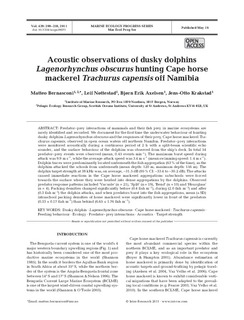| dc.description.abstract | Predator–prey interactions of mammals and their fish prey in marine ecosystems are rarely identified and recorded. We document for the first time the underwater behaviour of hunting dusky dolphins Lagenorhynchus obscurus and the responses of their prey, Cape horse mackerel Trachurus capensis, observed in open ocean waters off northern Namibia. Predator–prey interactions were monitored acoustically during a continuous period of 2 h with a split-beam scientific echo sounder, and the surface behaviour of the dolphins was observed from the ship’s deck. In total 54 predator–prey events were observed (mean, 0.45 events min–1). The maximum burst speed during attack was 9.9 m s–1, while the average attack speed was 3.4 m s–1 (mean swimming speed: 1.4 m s–1). Dolphin traces were predominantly located underneath the fish aggregation (63% of the time), as the dolphins attacked the schools from underneath (mean depth: 120 m; maximum depth: 156 m). The dolphin target strength at 38 kHz was, on average, –31.5 dB (95% CI: –33.4 to –30.2 dB). The attacks caused immediate reactions in the Cape horse mackerel aggregations: subschools were forced towards the surface where they were herded into dense aggregations by the dolphins. Observed predator response patterns included ‘Vacuole’ (n = 21), ‘Split’ (n = 19), ‘Bend’ (n = 10) and ‘Hourglass’ (n = 4). Packing densities changed significantly before (0.4 fish m–3), during (2.0 fish m–3) and after (0.3 fish m–3) the dolphin attacks, and when predators burst into the fish aggregations, mean (±SD) intraschool packing densities of horse mackerel were significantly lower in front of the predators (0.33 ± 0.17 fish m–3) than behind (6.65 ± 1.76 fish m–3). | no_NO |
